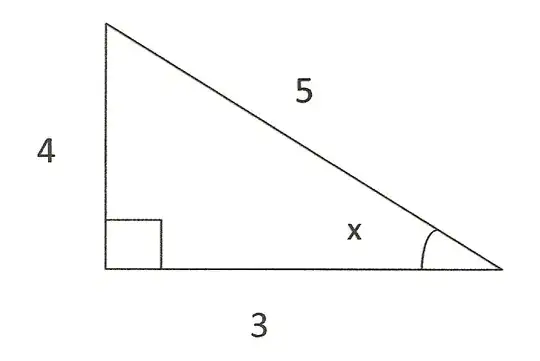I run into a problem when I'm trying to prove how $\tan^2x+1 = \sec^2x$, and $1+\cot^2x=\csc^2x$
I understand that $\sin^2x+\cos^2x = 1$. (To my understanding 1 is the Hypotenuse, please correct me if I'm wrong). If referring to a Pythagorean triangle, let's say a triangle where $a=3$, $b=4$, and $c=5$, or $a=\cos$ $b=\sin$ and $c=\text{hypotenuse}$.
$3^2 + 4^2 = 5^2$. Which is true and proves that this identity work. To my understanding, that is how this identity work.
However, when I try to make sense of the $\tan^2x+1 = \sec^2x$ and $1+\cot^2x=\csc^2x$ identity, using the triangle example from above, it doesn't work. For example, here's how I did it on paper,
$\tan^2x + 1 = {\sin^2x\over \cos^2x} + 1$, so I would get using the triangle above, ${4^2\over 3^2} + 1 = {16\over 9} + 1 = 2.777777778$
Now on the right hand side, $\sec^2x, = {1\over \cos^2x} = {1\over 3^2} = .1111111111$. The answer I get from $\tan^2x+1$ DOES NOT EQUAL the answer I get from $\sec^2x$. I think I may be misunderstanding a critical part here that I can't really pinpoint.
However, I do know that if I prove $\tan^2x+1 = \sec^2x$ using just the identity itself it does work, for example,
$\tan^2x+1 = {\sin^2x\over \cos^2x} + 1 = (\text{after some simplification}) = \sin^2x + {\cos^2x \over \cos^2x} = {1\over \cos^2x} = \sec^2x$.
The same issue happens with $1+\cot^2x=\csc^2x$.
To my understanding, $\sin^2+\cos^2=1$ is the same as $a^2+b^2=c^2$. Am I right or wrong? I think there is a huge concept that I am missing between the UNIT CIRCLE and just TRIANGLES.
 Let us go ahead and figure out our values of $\cos(x)$, $\sin(x)$, and $\tan(x)$:
Let us go ahead and figure out our values of $\cos(x)$, $\sin(x)$, and $\tan(x)$: